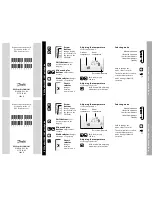
12
DS8241-03 January 2014
www.richtek.com
RT8241
©
Copyright 2014 Richtek Technology Corporation. All rights reserved. is a registered trademark of Richtek Technology Corporation.
If the V
OUT
change is significant, there can be several
consecutive cycle of UGATE on-time followed by minimum
LGATE time. This can cause a rapid increase in inductor
current: typically it only takes a few switching cycles for
inductor current to rise up to the current limit. At some
point the V
FB
will rise up to the new internal V
REF
and the
UGATE pulses will cease, but the inductor's LI
2
energy
must then flow into the output capacitor. This can create
a significant overshoot, as shown in Figure 5.
Figure 5. Output Voltage Up Transition with
Overshooting
This overshoot can be approximated by the following
equation, where I
CL
is the current limit, V
FINAL
is the
desired set point for the final voltage, L is in
μ
H and C
OUT
is in
μ
F.
2
2
CL
MAX
FINAL
OUT
I
L
V
(
) V
C
×
=
+
Current Limit Setting (OCP)
The RT8241 has a cycle-by-cycle current limiting control.
The current limit circuit employs a unique
“
valley
”
current
sensing algorithm. If the magnitude of the current sense
signal at the CS pin is above the current limit threshold,
the PWM is not allowed to initiate a new cycle (Figure.
6). In order to provide both good accuracy and a cost
effective solution, the RT8241 supports temperature
compensated MOSFET R
DS(ON)
sensing. The CS pin
should be connected to GND through the trip voltage setting
resistor, R
CS
. The 10
μ
A CS terminal source current , I
CS
,
and the trip voltage setting resistor, R
CS
, set the CS trip
CS
CS
V
(mV) = R
(k ) 10( A)
μ
Ω ×
The Inductor current can be monitored by the voltage
between GND and the PHASE pin. Hence, the PHASE
pin should be connected to the drain terminal of the low
side MOSFET. I
CS
has temperature coefficient to
compensate the temperature dependency of the R
DS(ON)
.
GND is used as the positive current sensing node, so
GND should be connected to the source terminal of the
bottom MOSFET.
While the comparison is being done during the OFF state,
V
CS
sets the valley level of the inductor current. Thus, the
load current at over-current threshold, I
LOAD_OC
, can be
calculated as follows :
ripple
CS
LOAD_OC
DS(ON)
CS
IN
OUT
OUT
DS(ON)
SW
IN
I
V
I
8 R
2
V
(V
V
) V
1
8 R
2 L f
V
=
+
×
−
×
=
+
×
×
× ×
In an over-current condition, the current to the load exceeds
the current to the output capacitor, thus causing the output
voltage to fall. Eventually the voltage crosses the under
voltage protection threshold and the device shuts down.
Figure 6. “ Vally” Current Limit
Negative Over Current Limit (PWM Only Mode)
The RT8241 supports cycle-by-cycle negative over current
limiting in CCM Mode only. The over current limit is set to
be negative but is the same absolute value as the positive
over current limit. If output voltage continues to rise, the
low side MOSEFT remains on. Thus, the inductor current
is reduced and reverses direction after it reaches zero.
When there is too much negative current in the inductor,
the low side MOSFET is turned off and the current flows
towards V
IN
through the body diode of the high side
MOSFET. Because this protection limits the discharge
current of the output capacitor, the output voltage tends
0
I
L
t
I
L_Peak
I
LOAD
I
LIM
voltage, V
CS
, as in the following equation.
GND
Gx
V
REF
Initial V
REF
Final V
REF
V
FB
UGATE
LGATE
Initial V
OUT
Final V
OUT
V
OUT


































